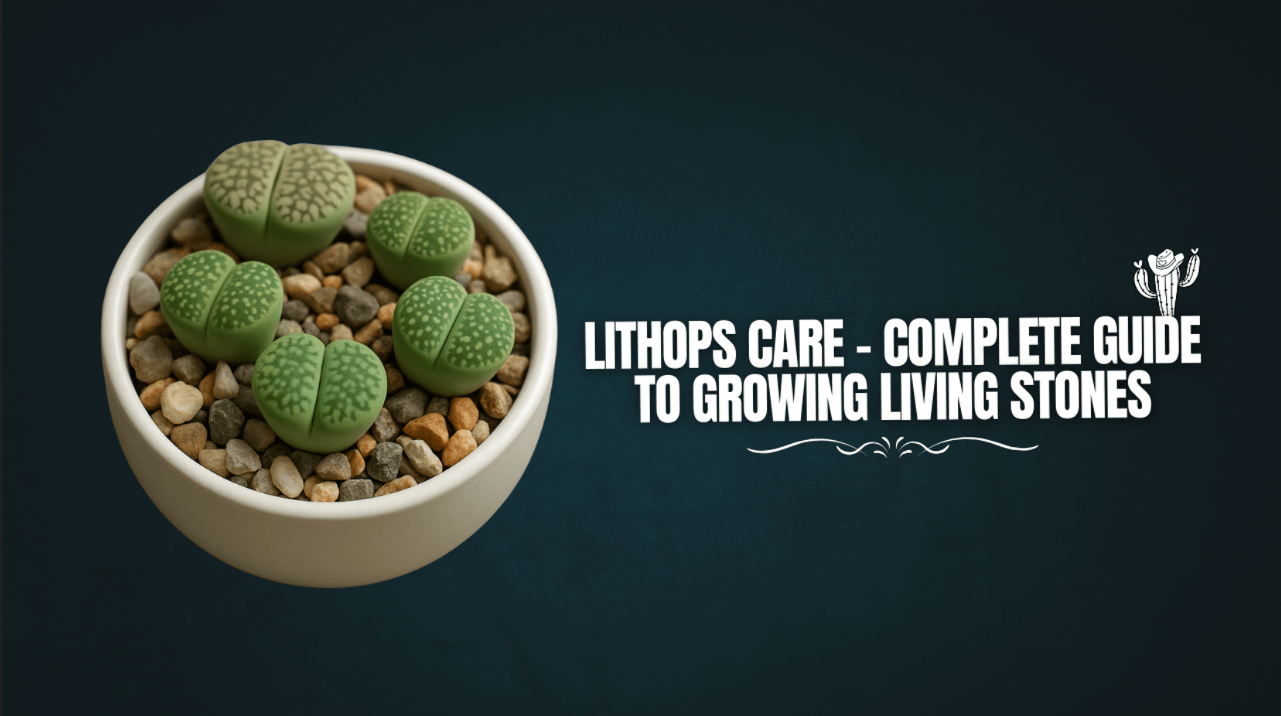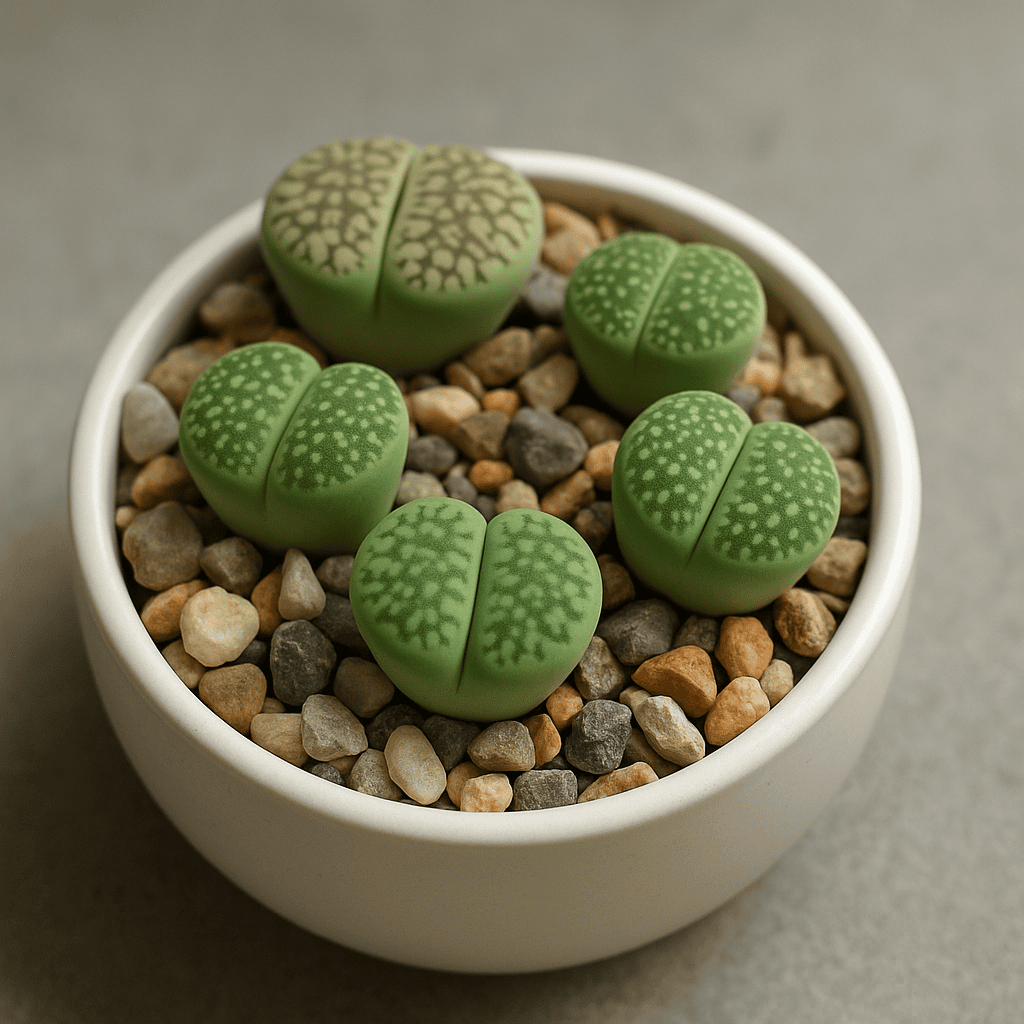Lithops, often called “living stones”, are one of the most fascinating succulents you can grow. Their unique stone-like appearance blends naturally with desert landscapes, yet they fit just as beautifully in modern interiors across Belgium and the Netherlands. For many plant lovers, Lithops are a symbol of minimalism, patience, and resilience. But here’s the challenge: Lithops care is very different from caring for regular mini succulents or cacti. They require precise watering, special soil conditions, and seasonal rest periods. In this guide, you’ll learn everything you need to know about growing Lithops successfully, whether you’re a beginner or an experienced succulent enthusiast.
Understanding Lithops: The Living Stones
Lithops are small succulents native to Southern Africa. Their name comes from the Greek word lithos, meaning “stone.” This is no coincidence: Lithops have evolved to camouflage themselves among rocks to avoid being eaten by grazing animals.
- Size: Usually between 1–5 cm in diameter
- Growth pattern: Two thick leaves that split once a year to form new growth
- Flowers: Daisylike blooms, often yellow or white, appear in autumn
- Lifespan: Can live up to 40–50 years with proper care
Their survival strategy makes them not just beautiful, but also incredibly rewarding for plant lovers who want something unique for their indoor plant collection.
Essential Lithops Care Basics
To grow Lithops successfully in Belgium or the Netherlands, you’ll need to mimic their natural desert conditions. Let’s break it down step by step.
1. Light Requirements for Lithops
Lithops need plenty of bright, direct sunlight to thrive.
- Place them near a south-facing window for maximum light exposure.
- If natural light is limited, especially in Belgian and Dutch winters, consider a grow light.
Too little sunlight causes Lithops to stretch, losing their compact stone-like shape.
2. Soil for Lithops
Regular potting soil is too rich and holds too much moisture. Lithops prefer:
- Cactus/succulent mix with extra sand or perlite
- A gritty, fast-draining medium with very little organic matter
This prevents root rot, the most common killer of Lithops.
3. Watering Lithops: The Most Important Rule
The golden rule: less is more.
- During active growth (spring and autumn), water sparingly once the soil is fully dry.
- In summer (dormancy) and winter (resting phase), do not water at all.
Overwatering leads to split leaves and rotting roots. Always remember: Lithops survive long droughts in nature.
4. Pot Choice
Modern plant pots in ceramic or terracotta are perfect for Lithops, as long as they have drainage holes. Shallow pots are often best since Lithops have small root systems.
Seasonal Lithops Care Guide
Lithops follow a unique yearly cycle. Understanding this rhythm is key.
Spring
- Old leaves begin to wither
- New leaves emerge
- Avoid watering until old leaves are fully dried
Summer
- Lithops enter dormancy
- Stop watering completely
- Provide plenty of light
Autumn
- Flowering season begins
- Light watering can resume
- Perfect time to admire yellow or white blooms
Winter
- Growth slows
- Do not water
- Keep them in a cool, bright environment
Lithops Care in Belgium and the Netherlands
Growing Lithops in Northern Europe comes with special challenges:
- Low light in winter → Use grow lights to supplement sunlight.
- High humidity → Ensure excellent airflow and never mist Lithops.
- Cold temperatures → Keep Lithops indoors when temperatures fall below 12°C.
This makes Lithops a perfect choice for indoor plant lovers who want to expand their succulent collection.
Common Problems with Lithops (and Solutions)
Even with the best care, you may encounter challenges.
- Wrinkled leaves → Sign of dehydration (time for a small drink if not in dormancy).
- Split or mushy leaves → Overwatering. Let the soil dry completely.
- No flowers → Lithops need to be mature (usually 3+ years old) and grown in bright light.
- Stretching (etiolation) → Move to a sunnier location.
Why Lithops Are Perfect for Mini Succulent Lovers
If you already enjoy mini succulents and mini cacti, Lithops add something truly unique to your collection. Their small size and stone-like appearance pair beautifully with modern plant pots, making them an ideal choice for:
- Minimalist interiors
- Office desks
- Small apartments in Belgium or the Netherlands
Where to Buy Lithops and Succulents Online
If you’re looking for Lithops, mini succulents, or modern plant pots, Succulux.be is the best platform to buy plants online in Belgium and the Netherlands. Whether you want to start your first Lithops collection or expand your mini cactus family, Succulux offers carefully selected plants and stylish pots for every home.
- Keyword optimization included: buy plants online Belgium, buy online plants.
Answer Engine Optimization (AEO): Quick Q&A
Below are concise, helpful answers designed to appear in featured snippets and voice search.
What is the best soil for Lithops?
Lithops grow best in a gritty, fast-draining soil mix with sand, pumice, or perlite. Avoid organic-rich soil.
How often should Lithops be watered?
Lithops should be watered sparingly only during their active growth periods (spring and autumn). Do not water in summer or winter.
Can Lithops survive in Belgium and the Netherlands?
Yes, Lithops can thrive indoors with plenty of sunlight or supplemental grow lights, provided they are not overwatered.
Do Lithops need fertilizer?
Generally, no. Lithops do not require fertilizer and can be damaged by excess nutrients.
How long do Lithops live?
With proper care, Lithops can live up to 40–50 years.
Are Lithops succulents or cacti?
Lithops are succulents, not cacti. They store water in their thick leaves.
Why are my Lithops splitting?
Splitting is normal when new leaves are forming, but if it happens irregularly, it could be due to overwatering.
Advanced Lithops Care Tips for Enthusiasts
For those who want to go beyond the basics:
- Repotting: Only repot when absolutely necessary, usually every 4–5 years.
- Seed propagation: Lithops can be grown from seed, but germination is slow and requires patience.
- Companion plants: Pair Lithops with other drought-tolerant mini succulents for a stylish modern arrangement.
Conclusion: Lithops Care in a Nutshell
Lithops are unlike any other plant. With the right balance of light, soil, and careful watering, these living stones will thrive for decades. Whether you’re a beginner curious about succulents or an experienced plant parent, Lithops offer beauty, patience, and charm in the smallest of packages.
For readers in Belgium and the Netherlands: Succulux.be is your trusted destination to buy mini succulents, mini cacti, Lithops, and modern pots online. Add these unique plants to your home and enjoy the satisfaction of growing one of nature’s most fascinating succulents.
FAQs (Extended)
Q: Can Lithops grow outside in Belgium?
A: Only in summer, and only if kept dry. Indoors is safer for year-round growth.
Q: Do Lithops need pruning?
A: No. Lithops naturally shed old leaves as new ones grow.
Q: Can I keep Lithops in an office?
A: Yes, if they get enough light. A grow light can help in darker offices.
Q: How many Lithops should I grow together?
A: Lithops look great in clusters. Many collectors place 3–5 in one shallow pot.
Q: Do Lithops attract pests?
A: Rarely, but mealybugs can sometimes appear. Treat with neem oil or insecticidal soap.



